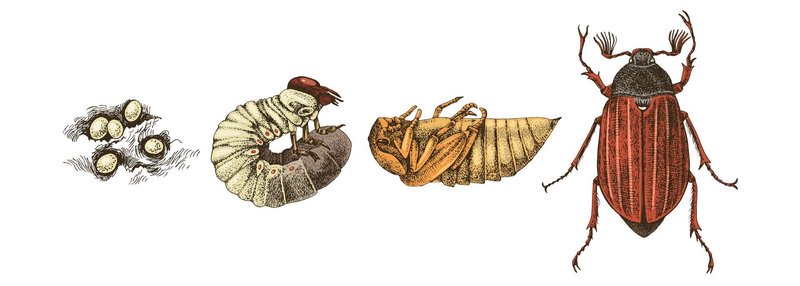
Beetles are part of a larger group called insects, and they come in all shapes and sizes. With over 350,000 species, these little critters can be found almost everywhere on Earth. So, what exactly happens in their lifecycle? Let’s dive into the different stages, from the moment a beetle egg is laid to when it finally grows into a vibrant adult.
The Egg Stage
The lifecycle of a beetle begins with the egg stage. This is where it all starts, and it’s pretty amazing when you think about it. A female beetle lays her eggs in places that provide a good chance for survival. This could be in soil, under leaves, or even inside decaying wood. Depending on the species, she can lay anywhere from a few to hundreds of eggs at once.
Once laid, the eggs are usually very small and often look like tiny grains of rice. They might blend in with their surroundings, making them less likely to be eaten by predators. The time it takes for the eggs to hatch can vary, but generally, they will remain in this stage for about a week to a month. Here’s the thing: the conditions, like temperature and humidity, play a big role in how long it takes for the eggs to hatch. You can imagine it as waiting for popcorn to pop—patiently anticipating that delightful moment!
Larvae: The Growing Phase
After the eggs hatch, we enter the larval stage. At this point, the beetles are called larvae, and they look quite different from their adult counterparts. Most beetle larvae resemble little worms or maggots and are usually quite voracious eaters. They munch on as much food as they can find, which is crucial for their growth.
During this stage, larvae often feed on organic material like decaying plant matter, leaves, or even fungi. You might picture them like teenagers raiding the refrigerator at midnight! The larval stage can last anywhere from a few weeks to several months, depending on the species and environmental conditions. During this time, they must avoid predators and other dangers, growing larger and stronger.
As they grow, they’ll go through several molting stages. Molting is when the larvae shed their outer skin to allow for further growth. This process can happen multiple times, with each molt marking a step closer to becoming an adult. Picture it like upgrading your clothes as you grow taller—eventually, you’ll fit into something that suits your adult style!
Pupa: The Transformation
After the larvae have matured, they enter the pupal stage. This is where the real magic happens! The larvae find a safe place to transform into pupae. At this point, they essentially go into hiding, and you might not even notice them. They often look like little cocoons, and this stage is crucial for development.
Inside the pupal casing, the beetles undergo a dramatic transformation. Their bodies break down and reorganize to take on their adult form. This process can take several weeks or even months, depending on the species. It’s like a caterpillar turning into a butterfly—everything changes!
During this stage, the beetle’s wings develop, and its body takes shape. The pupae are vulnerable to predators, but many beetles choose spots that provide protection. Honestly, as interesting as this stage is, it’s a bit like waiting for a surprise—what will emerge when the time is right?
The Adult Beetle
Finally, we reach the adult stage! After their time in the pupal casing, the fully developed beetles emerge. They often appear soft and pale initially, but within hours, their bodies harden, and their colors brighten up. This is the moment every beetle has been waiting for!
Adult beetles are typically defined by their tough outer shells, known as elytra. These protective coverings help shield them from predators and environmental hazards. You might be surprised by the variety of shapes, sizes, and colors that beetles come in! Some are tiny and plain, while others are large and brightly colored.
As adults, beetles usually have one primary goal: reproduce. They’ll look for mates to lay eggs and continue the lifecycle. Adult beetles can live for a few months to many years, depending on the species. For example, the well-known Japanese beetle can live for just a few months, while some woodboring beetles can stay alive for up to 30 years!
Importance of the Beetle Lifecycle
You might wonder why the beetle lifecycle matters. Well, these little creatures play a significant role in our ecosystem. They help decompose dead plant matter and recycle nutrients back into the soil. Without beetles, our environment would look very different.
Moreover, many beetles are vital pollinators and contribute to the health of plants and flowers. Some even help control pests by eating other insects. You can think of them as little workers in the garden, making sure everything runs smoothly.
Additionally, studying the lifecycle of beetles can teach us about biodiversity and even inspire new technologies and gardening techniques. They remind us that nature has a way of adapting and thriving, providing lessons we can all learn from.
The lifecycle of a beetle—from egg to adult—is a fascinating journey full of transformations. Each stage plays a crucial role in the development of these incredible insects. You’ve got the egg stage where it all begins, the larval stage filled with voracious eating, the pupal stage of transformation, and finally, the emergence of the adult beetle.
So, the next time you spot a beetle, take a moment to appreciate all the hard work and changes it went through to get there. Who knew that a tiny egg could lead to such a remarkable creature? Nature truly is amazing!
